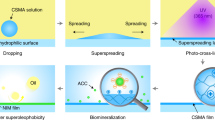Abstract
Bio-inspired surfaces are usually designed by imitating the surface properties of a particular biological species, or combing with the surface characteristics of multiple biological species to construct a cross-species surface. Herein, inspired by the structure and rhythmic swing of human pulmonary cilia, and the directional migration of pigeons by geomagnetic field, an integrated system of biomimetic hydrophobic magnetic cilia array surface with reversible deformation properties and excellent magnetic response performance for solid microspheres underwater transport is designed and constructed. Driven by an external magnetic field, the magnetic responsive cilia array surface can directionally and continuously transport microspheres underwater in periodic motion. This work will shed new light on the designing of micromanipulation systems for micro-objects transport, and promote the practical application of micro-operating systems in underwater transportation and drug delivery.
Similar content being viewed by others
References
Chakraborty C, Jungwirth NR, Fuchs GD, Vamivakas AN. Phys Rev B, 2019, 99: 045308
Velev OD, Bhatt KH. Soft Matter, 2006, 2: 738–750
Dienerowitz M, Mazilu M, Dholakia K. J Nanophoton, 2008, 2: 021875
Dholakia K, Reece P, Gu M. Chem Soc Rev, 2008, 37: 42–55
Paiè P, Zandrini T, Vázquez RM, Osellame R, Bragheri F. Micromachines, 2018, 9: 200
Quy HQ, Tuan DQ, Thanh TD, Thang NM. Opt Commun, 2018, 427: 341–347
Bentley AK, Farhoud M, Ellis AB, Nickel AML, Lisensky GC, Crone WC. J Chem Educ, 2005, 82: 765–768
Bentley AK, Trethewey JS, Ellis AB, Crone WC. Nano Lett, 2004, 4: 487–490
Jiang J, Gu H, Shao H, Devlin E, Papaefthymiou GC, Ying JY. Adv Mater, 2008, 20: 4403–4407
Huang HW, Sakar MS, Petruska AJ, Pané S, Nelson BJ. Nat Commun, 2016, 7: 12263
Belharet K, Folio D, Ferreira A. Adv Robotics, 2012, 25: 1069–1083
Amirouche F, Zhou Y, Johnson T. Microsyst Technol, 2009, 15: 647–666
Shields AR, Fiser BL, Evans BA, Falvo MR, Washburn S, Superfine R. Proc Natl Acad Sci USA, 2010, 107: 15670–15675
den Toonder JMJ, Onck PR. Trends Biotech, 2013, 31: 85–91
Lu H, Zhang M, Yang Y, Huang Q, Fukuda T, Wang Z, Shen Y. Nat Commun, 2018, 9: 3944
Amokrane W, Belharet K, Souissi M, Grayeli AB, Ferreira A. Robot Autonom Syst, 2018, 107: 10–19
Seo KS, Wi R, Im SG, Kim DH. Polym Adv Technol, 2013, 24: 1075–1080
Wu W, Cheng L, Bai S, Wang ZL, Qin Y. Adv Mater, 2012, 24: 817–821
Belardi J, Schorr N, Prucker O, Rühe J. Adv Funct Mater, 2011, 21: 3314–3320
Drotlef DM, Blümler P, del Campo A. Adv Mater, 2014, 26: 775–779
Shah AS, Ben-Shahar Y, Moninger TO, Kline JN, Welsh MJ. Science, 2009, 325: 1131–1134
Riedel IH, Kruse K, Howard J. Science, 2005, 309: 300–303
Ben S, Zhou T, Ma H, Yao J, Ning Y, Tian D, Liu K, Jiang L. Adv Sci, 2019, 6: 1900834
Fawcett D. Cilia and fiagella. In: Brachet J, Mirsky AE, Eds. The Cell, Volume 2: Cells and their Component Parts. London: Academic Press, 1961, 217–297
Gueron S, Liron N. Biophys J, 1992, 1045–1058
Sleigh MA. Fluid propulsion by cilia and the physiology of ciliary systems. In: Davies PS, Ed. Perspectives in Experimental Biology, Volume 1: Zoology. Oxford: Pergamon Press, 1976. 125–134
Ben S, Tai J, Ma H, Peng Y, Zhang Y, Tian D, Liu K, Jiang L. Adv Funct Mater, 2018, 28: 1706666
Cheema MAM, Fletcher JE, Farshadnia M, Xiao D, Rahman MF. IEEE Trans Ind Electron, 2017, 64: 3489–3501
Coey JMD. J Magn Magn Mater, 2002, 248: 441–456
Vokoun D, Tomassetti G, Beleggia M, Stachiv I. J Magn Magn Mater, 2011, 323: 55–60
Acknowledgements
This work was supported by the National Natural Science Foundation of China (21871020), the Beijing Young Talent Support Program, the 111 Project, the Fundamental Research Funds for the Central Universities and the Academic Excellence Foundation of BUAA for PhD Students.
Author information
Authors and Affiliations
Corresponding author
Ethics declarations
Conflict of interest The authors declare that they have no conflict of interest.
Rights and permissions
About this article
Cite this article
Ben, S., Yao, J., Ning, Y. et al. A bioinspired magnetic responsive cilia array surface for microspheres underwater directional transport. Sci. China Chem. 63, 347–353 (2020). https://doi.org/10.1007/s11426-019-9660-5
Received:
Accepted:
Published:
Issue Date:
DOI: https://doi.org/10.1007/s11426-019-9660-5




